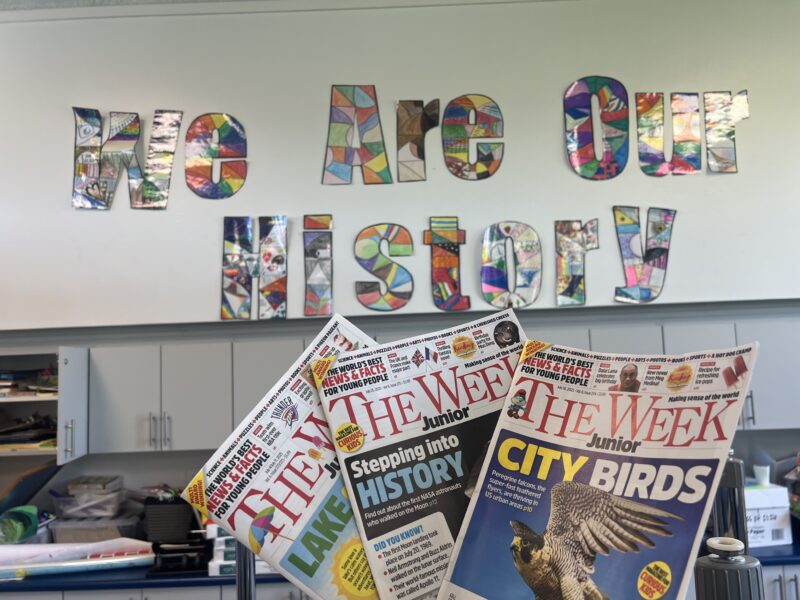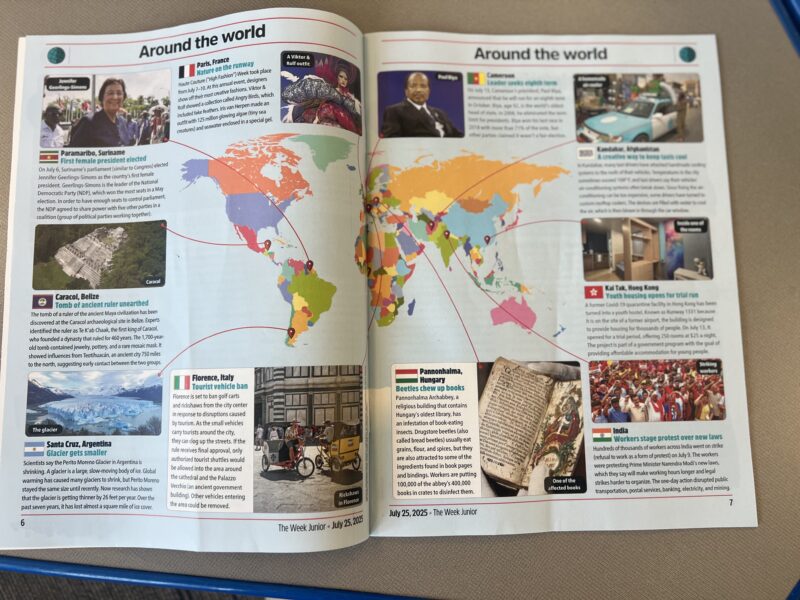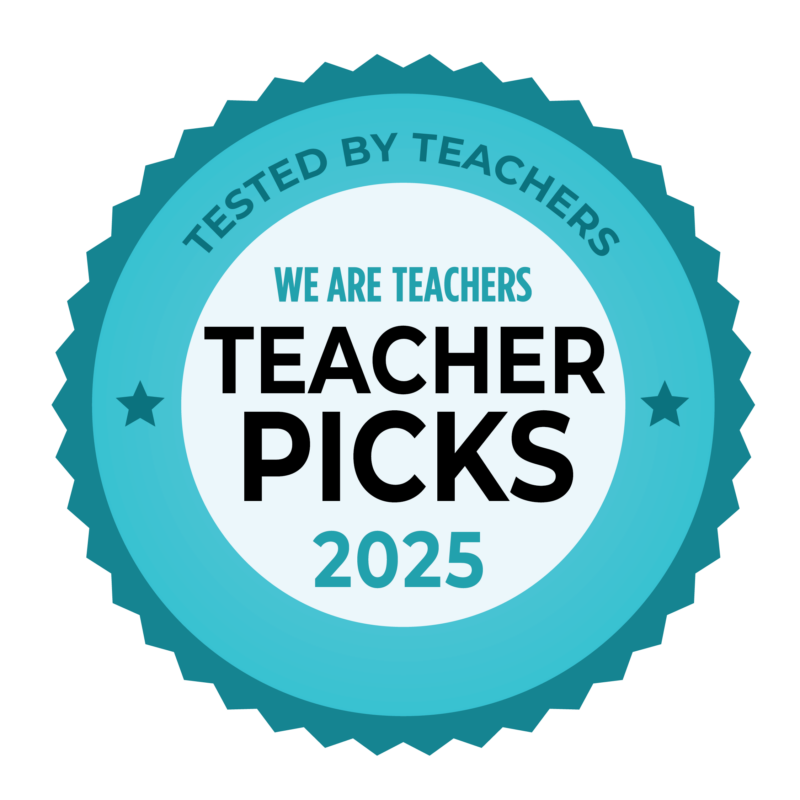The Week Junior is more than just a current events magazine for kids—it’s a flexible teaching tool that brings real-world topics into the classroom in a way that’s engaging, age-appropriate, and easy to use. Whether you’re sparking discussion in morning meetings, building reading comprehension, or connecting lessons to social studies and science, this magazine helps students think critically, ask questions, and stay curious. With ready-to-use articles and a wide range of topics, it fits seamlessly into any lesson plan.
California teacher Joanne Davi has been using The Week Junior with her upper elementary students across multiple subjects and says it makes her life so much easier. Here’s her Teacher Pick review and why she recommends using The Week Junior every week in your classroom.
Why is The Week Junior great for grades 4 through 8 as well as many different subject areas?
It’s an excellent resource for upper elementary and middle school students. The articles are high interest, relevant, and accessible for readers. Complex and important current events are broken down by giving context and facts. Even highly politicized topics are covered in a balanced manner that allows students to form their own opinions.
I see many uses for The Week Junior in the classroom, and it’s the versatility of the magazine that I find most valuable. The articles can be used in many settings: station work, teacher-led instruction, extension activities for early finishers, or partner jigsaw.
I teach 4th through 8th grades and can see the magazine fitting into all of my classes. My focus is ELA and social studies, but each issue also contains articles geared toward science, so a teacher in a self-contained setting would find the magazine useful across multiple content areas.
Does The Week Junior align with any specific standards or curriculum guidelines?
The Week Junior aligns with subject-specific and Common Core Standards for reading informational text:
- Quote accurately from a text when explaining what the text says explicitly and when drawing inferences from the text.
- Determine two or more main ideas of a text and explain how they are supported by key details; summarize the text.
- Explain the relationships or interactions between two or more individuals, events, ideas, or concepts in a historical, scientific, or technical text based on specific information in the text.
- Determine the meaning of general academic and domain-specific words and phrases in a text relevant to a grade 5 topic or subject area.
- Draw on information from multiple print or digital sources, demonstrating the ability to locate an answer to a question quickly or to solve a problem efficiently.
How do you use The Week Junior in your classroom?
I use The Week Junior in multiple ways. At the start of the year, we do whole-class instruction using the News of the World section to read about and summarize current events. Using that as a model, I then transition students into a collaborative station to read/summarize/pull main ideas out of the articles. I also encourage students to read articles of their choice as extension activities. As a special treat, we might also vote on a recipe to make and enjoy together as a class.
Additionally, the Photo of the Week section is a great resource for a hook activity. It’s perfect for notice/wonder/inference practice because the pictures are vivid and detailed, and the context or topic is not immediately obvious. The pictures can also serve as a creative writing prompt or even the basis of a mini research project.
How do your students react to The Week Junior?
The cover itself appeals to upper elementary school students and grabs their attention. The magazine doesn’t talk down to students but instead lifts their thinking. One of my rising 4th graders grabbed a copy of the magazine (unprompted by me) and read it cover to cover independently. He came to me for definitions of unknown words and asked me follow-up questions on the conflict in the Middle East. The articles piqued his curiosity and started meaningful discussions. I imagine many of my students will share this experience, especially if I give them choices with their article selection.

How would you sum up your overall experience using The Week Junior?
Overall, The Week Junior is a wonderful resource because it eliminates hours of planning each week and helps me incorporate current events and other nonfiction informational text into my class. Instead of having to curate texts for myself every week, now I have them all in one place. Also, I’m still able to give my students choices because of the variety of articles and sections in each issue.
How easy was it to use and implement the magazine in your classroom?
The magazine is incredibly easy to implement because of the variety of articles and images. The articles are short enough that I can preview them quickly, but detailed enough that my students can spend some time reading and discussing them. I was also able to create a worksheet that easily applies to any of the articles in each issue.
What were the top two features you liked most about The Week Junior?
I like the news stories for their accessibility and length. The topics are covered thoroughly but are also a quick enough read that students can read multiple articles in one session. I also appreciate how potentially divisive topics are covered in a balanced way that presents the facts of the situation without inserting opinion or trying to sway the reader. Identifying solid sources and checking for biases is a part of my class, and I’ve declined to use other curriculum due to obvious slants. I found The Week Junior’s presentation of topics to be purely informational, and I see it as a trusted source to give to my students.

What makes The Week Junior unique compared to other magazines you’ve used in your classroom?
I honestly haven’t used other magazines in my classroom because I was not satisfied with the content. The Week Junior is the first magazine I’m happy to use.
What I’ve used instead are online platforms that have informational texts leveled for students. I much prefer to get my students off devices and to engage with each other instead of a screen. Having a hard-copy magazine brings a tactile element to learning that needs to come back. It also allows me to have students work with each other by doing partner reads.
How does The Week Junior save you time?
Using The Week Junior as my nonfiction text source saves me the time it usually takes to curate articles myself from other sources. I spend an inordinate amount of time trying to find articles for my students that are relevant and interesting. The Week Junior has them all in one place.
Additionally, having a hard-copy text—without having to download/print/copy articles—gives my students a more hands-on experience and a much needed break from devices.
How do you plan to use The Week Junior again in the future?
I plan on making The Week Junior a part of every week going forward and will recommend it to other teachers. I want my students reading and discussing at least one article per week, and working together in stations to pull main ideas and supporting details.
I will also save the Photos of the Week to use for notice/wonder/inference practice.
As a teacher with over 15 years of experience, I can confidently say The Week Junior has been a game changer in my classroom. My students are genuinely excited to read it, and it sparks meaningful conversations and curiosity. I’ll definitely be using it regularly and recommending it to my colleagues.

Teacher Picks is a sponsored program available from We Are Teachers. All opinions shared in the review are honest and based on the teacher’s direct experience. To learn more about our guidelines and review process, click here.


